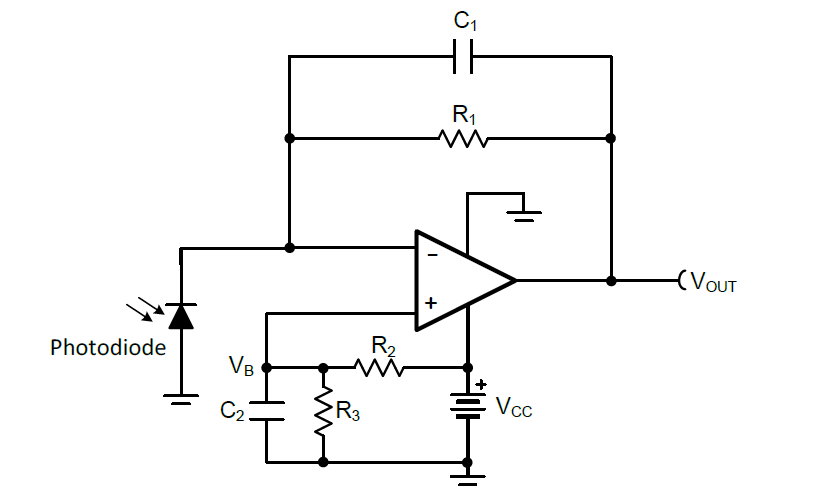SSZT655 august 2018 LM2904-Q1 , OPA348-Q1
As the sun sets on commuters driving home for the day, the displays and systems in each car gradually brighten. The manual adjustments required to brighten or dim the display in older vehicles have been replaced by intuitive lighting that adjusts without any action from the driver.
Operational amplifiers (op amps) are a simple way to provide backlighting control throughout the car to give drivers a comfortable viewing experience and save power. Using an op amp instead of a more complex light sensor also enables greater flexibility and customization.
Designing the Op Amp in a Transimpedance Configuration
Transimpedance in Automotive
 Figure 1 Transimpedance amplifier
configuration with a reverse-offset bias at the noninverting input
Figure 1 Transimpedance amplifier
configuration with a reverse-offset bias at the noninverting inputThe photodiode amplifier enables you to customize the circuit based on your needs. By strategically choosing any automotive-rated op amp or modifying the components in the circuit, you can control the gain, ensure the correct input bias current or add compensation to fix any unique stability issues. Additionally, there are many automotive-rated op amps available for each specific application. For example, TI’s OPA348-Q1 is specifically designed for very low-level photodiode current at 45μA and can operate over an extended bandwidth of 1MHz.
Alternatively, TI’s LM2904-Q1 consists of two independent frequency-compensated op amps with a gain-bandwidth product of 0.7MHz. Using op amps provides an economic solution to automatic adjustment: these op amps cost less than $.25 1,000-unit quantities, while an integrated circuit that performs the same function can cost $1.14 in 1,000-unit quantities with very little increase in performance.
Photodiode amplifier circuits are a simple and flexible way to automatically measure the backlighting for many automotive systems. TI’s library of op amps and resources to aid in proper circuit design enable you to tailor the perfect solution for your backlight control. A transimpedance configuration in an automotive display system will lead to automatic backlight control that is simple, inexpensive and effective.
Additional Resources
- Calculate the component values using a cookbook for a photodiode amplifier circuit.
- Review the app note, "Using transimpedance amplifiers for ambient light sensing in automotive displays"
- Read Bonnie Baker’s Analog Applications Journal article, “Automating circuit designs for photodiode amplifiers.”
- Check out the 1MHz, Single-Supply, Photodiode Amplifier Reference Design.
- Explore TI’s automotive solutions portal and op amps.
